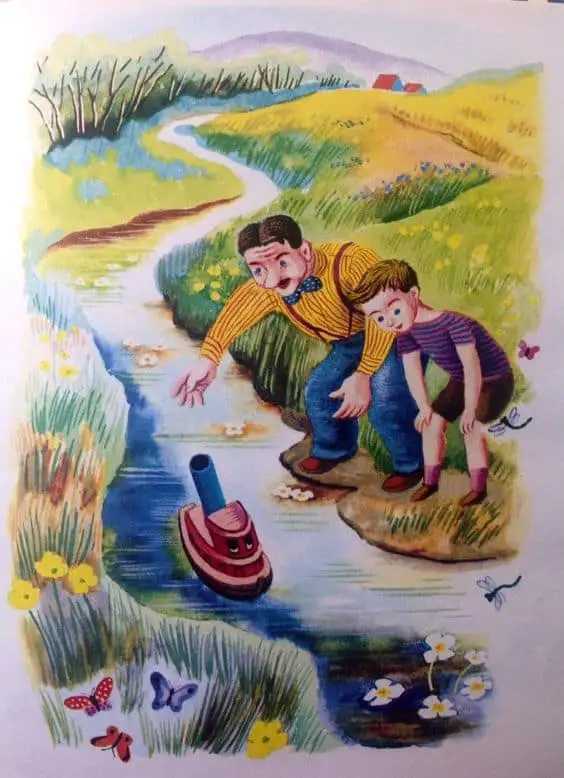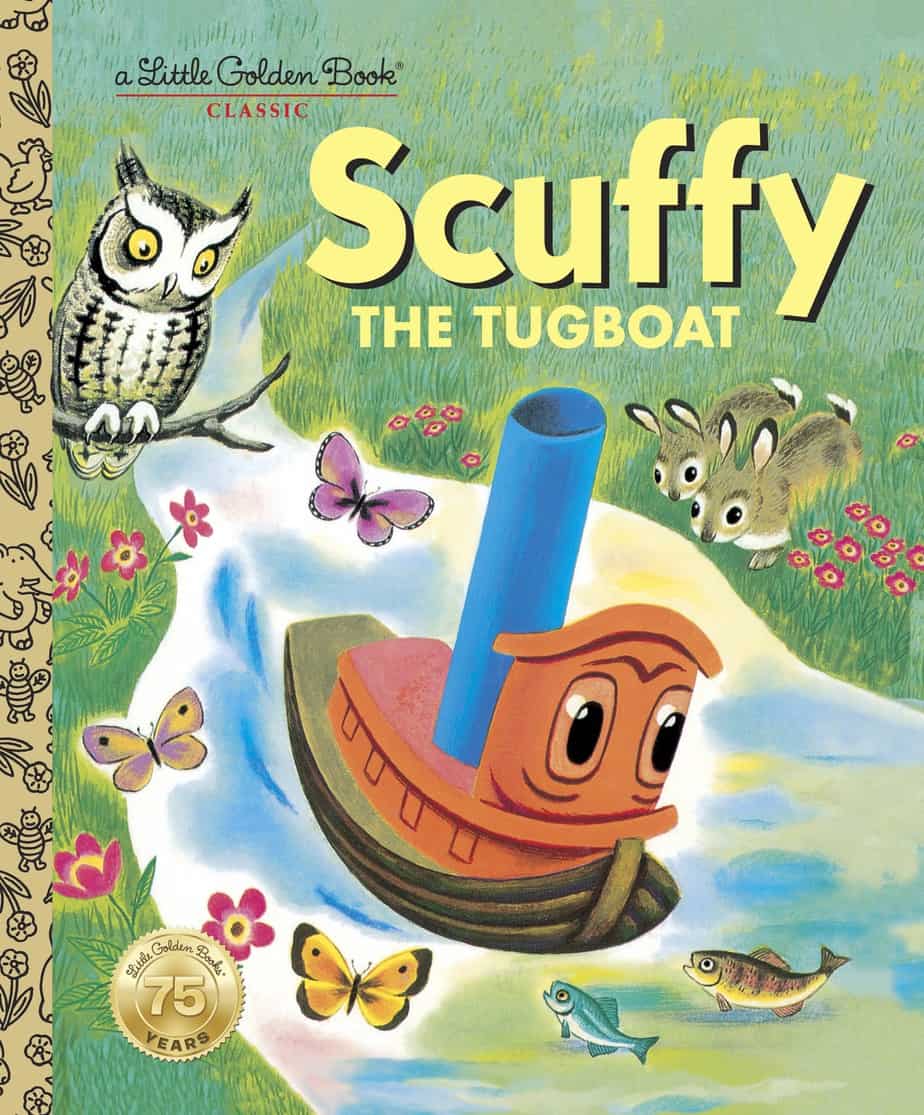The Little Golden Books series was launched in 1942, just as the second world war ended. Children needed to hunker down with cosy stories (along with their parents). Scuff The Tugboat was one of the earlier publications of this highly successful franchise, first printed in 1946, and the epitome of ‘cosy’. Now you can buy an edition with a big 75th Birthday Celebrations on the front.
What makes this book a classic? Is there anything special about it, to be replicated by modern picture book writers?
STORY STRUCTURE OF SCUFFY THE TUGBOAT

The full title: Scuffy The Tugboat and His Adventures Down The River. Obviously, the river is highly symbolic.
But apart from the ‘pull along’ drag of it, in which there’s no going back, the river in this story could easily be a road and the main character could easily be walking down a path. Scuffy The Tugboat is your classic mythic structure: A character leaves home in search of something, meets various trials and tribulations along the way and either returns home or finds a new home, having learned something new about himself.
But this is the little kid version of a mythic journey — all suggestion, nothing followed through or explored in depth. A cosy myth, in other words. The illustrations by Tibor Gergely are also cosy in their palette and subject matter. (I like the concept of hygge to describe ‘cosy’ in picture books.)
SHORTCOMING
Scuffy was sad. Scuffy was cross.
The story opens with the shortcoming of the main character with no mucking about.
“A toy store is no place for a red-painted tug-boat,” said Scuffy, and he sniffed his blue smoke-stack again.
Scuffy’s shortcoming: He feels cooped up and under utilised in the toy store.
Talking toys in children’s literature pretty much play the same role in storytelling as talking animals.
DESIRE
This is a case of a character mistaking their malaise (desire) in their self-diagnosis. Scuffy thinks he wants to go out into the wide world, but he’ll learn that’s not what he wants at all. That’s what he wants on the surface, but deep down he wants a family.
I was meant for bigger things.
The journey will teach him what those bigger things are.
OPPONENT
The opposition in this story revolves around size.
Making Use of the Miniature In Storytelling
It eventually becomes clear to Scuffy that he is too small to survive in such a big world. Along the way he meets various cosy opponents:
- The cow who almost drinks him by accident
- The owl which hoots and gives him a bit of a scare
- The men inadvertently blocking his way because they’re trying to pry free some floating logs. They won’t listen to the little tugboat.
PLAN
Scuffy’s plan is to float down the river. He is self-important and speaks as if he owns the river. But eventually, when he realises the river is pulling him along and that he is stuck on this journey, he realises the plan belongs to the river, not to him.
The river moved faster and faster.
“I feel like a train instead of a tugboat,” said Scuffy, as he was hurried along.
BIG STRUGGLE
The Battle sequence begins with the pathetic fallacy of the rain coming down, which tends to make water choppy and dangerous.
Faster and faster it flowed.
The river itself, which started out as a brook, is now perilous for a tiny boat. Men come rushing to fight the flood with sandbags and whatnot. This is the big Battle scene.
ANAGNORISIS
“Oh, oh!” cried Scuffy when he saw the sea. “There is no beginning and there is no end to the sea. I wish I could find the man with the polka dot tie and his little boy!”
NEW SITUATION
The man with the polka dot tie has known all along that Scuffy would want to be saved right before the perilous journey into the sea, so in a scene that’s basically deus ex machina, the man with the polka dot tie plucks Scuffy out of the water and saves him.
Now that Scuffy has been on his big journey and learned how small he is compared to the world, he is happy to float in the bathtub at home.
WHERE DOES SCUFFY THE TUGBOAT FIT IN THE HISTORY OF CHILDREN’S LITERATURE?
Scuffy was published at a time when children’s books were undergoing a change. Scuffy appeared near the end of the First Golden Age of Children’s Literature and helped ushered in the Second.
Scuffy The Tugboat presents to young children a world which is big and scary. It ultimately says: The world is big and scary — way more scary than you know. You may have dreams, but the best place for you is at home, safe with your family.
I suspect this is how many people were feeling in the aftermath of the second war. Older adults had lived through two major crises. Most of the book buying public had suffered great loss.
I suggest that is why there’s nothing subversive or daring about this book. Scuffy the character does something bold, but child readers are not expected to emulate his attitude, which is presented to the reader as arrogance rather than confidence. By the end of the story Scuffy’s arrogance has been ‘fixed’. He knows his place.
Scuffy the Tugboat feels quite different from anything published today, in which children are respected to the point where they are told they can save the world — if not today, then one day. In contemporary children’s books, when children return to the safety of home, they are more likely to have earned independence, and the reader extrapolates that this journey out into the world was the first of many more.
Ironically, modern children have far smaller worlds than the baby boomers who were reading Scuffy the Tugboat. For many of today’s children, the most freedom they ever get ‘out in the world’ is the world they see through books and other media. Perhaps there’s no irony here at all. Perhaps we can expect, in any era, children’s books to afford exactly the freedoms denied to the young readers who enjoy them.

